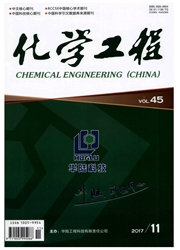

 中文摘要:
中文摘要:
泡状液体广泛存在于化工、食品和生物医学等领域,深刻理解气泡对液相流变特性的影响对于产品质量改进和过程强化具有重要意义。文中以旋转流变仪作为物理模型,基于VOF和动网格相结合的方法,详细研究了分散气泡对液相表观黏度的影响。目前的研究发现:在相同气泡体积分数下,当毛细数较小时,由于表面张力,气泡几乎保持为球形,气泡的加入使流线扭曲,从而导致液相的相对黏度增大(即η_r〉1);然而,当毛细数较大时,气泡由圆形变为细长的椭圆形,并且沿最大法线方向气泡所占比例增加,气泡的加入使液相的相对黏度减小(即η_r〈1);而且对于相同毛细数的工况,体积分数越大,气泡对液相表观黏度的影响也越大。
 英文摘要:
英文摘要:
Bubbly liquid exists widely in chemical, food and biomedical fields, so the deep understanding of rheologic properties of bubbly liquid has great significance for improving product's quality and for strengthening industrial process. The numerical method based on the combination of VOF ( Volume of Fluid) with the dynamic mesh was applied to simulate the influence of the dispersed bubbles on the apparent viscosity of the liquid phase in the rotating circular ring. The results show that, for the same volume fraction of bubbles, when the capillary number of bubbles is relatively small, the bubbles are almost spherical due to the surface tension. And the flow lines distortion is sharp for adding the bubble, which increases the liquid-phase relative viscosity ( ~r 〉 1 ). However, when the capillary number is large, the spherical bubbles deforms into ones with the oval shape, and the bubble void fraction increases in the maximum normal direction. The liquid-phase relative viscosity (r/r 〈 1 ) decreases due to injecting the bubble. For the same capillary number, the higher the bubble void fraction is, the more obviously the liquid-phase relative viscosity changes
 同期刊论文项目
同期刊论文项目
 同项目期刊论文
同项目期刊论文
 期刊信息
期刊信息
